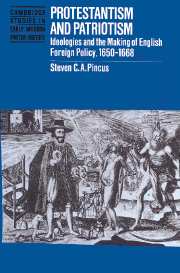Book contents
- Frontmatter
- Contents
- Acknowledgments
- List of abbreviations
- 1 Introduction
- Part I The rod of the Lord: ideology and the outbreak of the First Anglo-Dutch War
- Part II To unite against the common enemy: the 1654 Treaty of Westminster and the end of apocalyptic foreign policy
- Part III Popery, trade, and universal monarchy: ideology and the outbreak of the Second Anglo-Dutch War
- 11 Historiographical overview
- 12 The establishment of an Orangist foreign policy
- 13 The Anglo-Dutch treaty of 1662
- 14 The Northern Rebellion and the reestablishment of Anglican Royalist consensus
- 15 The April 1664 trade resolution
- 16 Popery, trade, and universal monarchy
- Part IV The Medway, Breda, and the Triple Alliance: the collapse of Anglican Royalist Foreign Policy
- Conclusion
- Bibliography
- Index
- Titles in the series
14 - The Northern Rebellion and the reestablishment of Anglican Royalist consensus
Published online by Cambridge University Press: 01 October 2009
- Frontmatter
- Contents
- Acknowledgments
- List of abbreviations
- 1 Introduction
- Part I The rod of the Lord: ideology and the outbreak of the First Anglo-Dutch War
- Part II To unite against the common enemy: the 1654 Treaty of Westminster and the end of apocalyptic foreign policy
- Part III Popery, trade, and universal monarchy: ideology and the outbreak of the Second Anglo-Dutch War
- 11 Historiographical overview
- 12 The establishment of an Orangist foreign policy
- 13 The Anglo-Dutch treaty of 1662
- 14 The Northern Rebellion and the reestablishment of Anglican Royalist consensus
- 15 The April 1664 trade resolution
- 16 Popery, trade, and universal monarchy
- Part IV The Medway, Breda, and the Triple Alliance: the collapse of Anglican Royalist Foreign Policy
- Conclusion
- Bibliography
- Index
- Titles in the series
Summary
Despite the uneasy peace of 1662, less than three years later English and Dutch navies would be fighting on the coast of Africa, the Mediterranean, and ultimately in the Channel. Why did this happen? Why had a government which in 1662 feared for its very existence, opted so quickly to test itself in the field of international conflict? Much of the answer lies in the changing domestic political scene.
Although no great rising had materialized in 1662, the government did not emerge unscathed from the political maneuvers of 1662. The government, including the Earl of Clarendon as Charles's chief minister, was attacked for corruption. Clarendon was accused of having sold Dunkirk for personal profit, of having married Charles to a barren Portuguese princess to ensure the succession of his daughter Anne's children by the Duke of York, and having taken bribes variously from France, the United Provinces, and Portugal.
Parliament, in the session of 1663, demonstrated a temper far different from that of the previous year. Factional strife rather than the ordered implementation of government legislation was the business of both houses. Sir Philip Warwick observed to Pepys “how obedient this Parliament was for a while; and the last sitting, how they begun to differ and to carp at the king's officers.” “Most of my time is taken up with the business of the Parliament in getting them to do what is best for us all,” Charles complained to his sister, “and keeping them from doing what they ought not to do.”
- Type
- Chapter
- Information
- Protestantism and PatriotismIdeologies and the Making of English Foreign Policy, 1650–1668, pp. 222 - 236Publisher: Cambridge University PressPrint publication year: 1996



